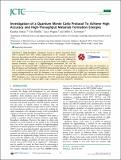Investigation of a Quantum Monte Carlo Protocol To Achieve High Accuracy and High-Throughput Materials Formation Energies
Author(s)
Saritas, Kayahan; Mueller, Tim; Wagner, Lucas; Grossman, Jeffrey C.
DownloadGrossman_Investigation of a quantum.pdf (989.9Kb)
PUBLISHER_POLICY
Publisher Policy
Article is made available in accordance with the publisher's policy and may be subject to US copyright law. Please refer to the publisher's site for terms of use.
Terms of use
Metadata
Show full item recordAbstract
High-throughput calculations based on density functional theory (DFT) methods have been widely implemented in the scientific community. However, depending on both the properties of interest as well as particular chemical/structural phase space, accuracy even for correct trends remains a key challenge for DFT. In this work, we evaluate the use of quantum Monte Carlo (QMC) to calculate material formation energies in a high-throughput environment. We test the performance of automated QMC calculations on 21 compounds with high quality reference data from the Committee on Data for Science and Technology (CODATA) thermodynamic database. We compare our approach to different DFT methods as well as different pseudopotentials, showing that errors in QMC calculations can be progressively improved especially when correct pseudopotentials are used. We determine a set of accurate pseudopotentials in QMC via a systematic investigation of multiple available pseudopotential libraries. We show that using this simple automated recipe, QMC calculations can outperform DFT calculations over a wide set of materials. Out of 21 compounds tested, chemical accuracy has been obtained in formation energies of 11 structures using our QMC recipe, compared to none using DFT calculations.
Date issued
2017-05Department
Massachusetts Institute of Technology. Department of Materials Science and EngineeringJournal
Journal of Chemical Theory and Computation
Publisher
American Chemical Society (ACS)
Citation
Saritas, Kayahan et al. “Investigation of a Quantum Monte Carlo Protocol To Achieve High Accuracy and High-Throughput Materials Formation Energies.” Journal of Chemical Theory and Computation 13, 5 (April 2017): 1943–1951 © 2017 American Chemical Society
Version: Author's final manuscript
ISSN
1549-9618
1549-9626